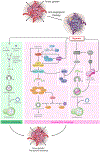Autophagy as a mechanism for anti-angiogenic therapy resistance
- PMID: 31472232
- PMCID: PMC7047534
- DOI: 10.1016/j.semcancer.2019.08.031
Autophagy as a mechanism for anti-angiogenic therapy resistance
Abstract
Autophagy is a lysosomal-dependent degradation process that is highly conserved and maintains cellular homeostasis by sequestering cytosolic material for degradation either non-specifically by non-selective autophagy, or targeting specific proteins aggregates by selective autophagy. Autophagy serves as a protective mechanism defending the cell from stressors and also plays an important role in enabling tumor cells to overcome harsh conditions arising in their microenvironment during growth as well as oxidative and non-oxidative injuries secondary to therapeutic stressors. Recently, autophagy has been implicated to cause tumor resistance to anti-angiogenic therapy, joining an existing literature implicating autophagy in cancer resistance to conventional DNA damaging chemotherapy and ionizing radiation. In this review, we discuss the role of angiogenesis in malignancy, mechanisms of resistance to anti-angiogenic therapy in general, the role of autophagy in driving malignancy, and the current literature in autophagy-mediated anti-angiogenic therapy resistance. Finally, we provide future insight into the current challenges of using autophagy inhibitors in the clinic and provides tips for future studies to focus on to effectively target autophagy in overcoming resistance to anti-angiogenic therapy.
Keywords: Angiogenesis; Anti-angiogenesis; Autophagy; Cancer; Drug resistance; VEGF.
Copyright © 2019 Elsevier Ltd. All rights reserved.
Conflict of interest statement
Declaration of Competing Interest
None.
Figures


Similar articles
-
Tumor cell autophagy as an adaptive response mediating resistance to treatments such as antiangiogenic therapy.Cancer Res. 2012 Sep 1;72(17):4294-9. doi: 10.1158/0008-5472.CAN-12-1076. Epub 2012 Aug 22. Cancer Res. 2012. PMID: 22915758 Free PMC article. Review.
-
Hypoxia-induced tumor cell autophagy mediates resistance to anti-angiogenic therapy.Autophagy. 2012 Jun;8(6):979-81. doi: 10.4161/auto.20232. Epub 2012 Jun 1. Autophagy. 2012. PMID: 22714142 Free PMC article.
-
Role of the hypoxic tumor microenvironment in the resistance to anti-angiogenic therapies.Drug Resist Updat. 2009 Jun;12(3):74-80. doi: 10.1016/j.drup.2009.03.002. Epub 2009 Apr 25. Drug Resist Updat. 2009. PMID: 19394890 Free PMC article. Review.
-
Anti-Angiogenic Therapy: Current Challenges and Future Perspectives.Int J Mol Sci. 2021 Apr 5;22(7):3765. doi: 10.3390/ijms22073765. Int J Mol Sci. 2021. PMID: 33916438 Free PMC article. Review.
-
Role of the tumor stroma in resistance to anti-angiogenic therapy.Drug Resist Updat. 2016 Mar;25:26-37. doi: 10.1016/j.drup.2016.02.002. Epub 2016 Feb 24. Drug Resist Updat. 2016. PMID: 27155374 Review.
Cited by
-
Synergy of Polydopamine Nanovaccine and Endostar Alginate Hydrogel for Improving Antitumor Immune Responses Against Colon Tumor.Int J Nanomedicine. 2022 Oct 12;17:4791-4805. doi: 10.2147/IJN.S372048. eCollection 2022. Int J Nanomedicine. 2022. PMID: 36246936 Free PMC article.
-
Essential role for STAT3/FOXM1/ATG7 signaling-dependent autophagy in resistance to Icotinib.J Exp Clin Cancer Res. 2022 Jun 11;41(1):200. doi: 10.1186/s13046-022-02390-6. J Exp Clin Cancer Res. 2022. PMID: 35690866 Free PMC article.
-
Regulation of autophagy fires up the cold tumor microenvironment to improve cancer immunotherapy.Front Immunol. 2022 Oct 10;13:1018903. doi: 10.3389/fimmu.2022.1018903. eCollection 2022. Front Immunol. 2022. PMID: 36300110 Free PMC article. Review.
-
Effects of neratinib on angiogenesis and the early stage of the embryo using chicken embryo as a model.Biomol Biomed. 2024 May 2;24(3):575-581. doi: 10.17305/bb.2023.9869. Biomol Biomed. 2024. PMID: 38158791 Free PMC article.
-
Pharmacogenetic Association between Allelic Variants of the Autophagy-Related Genes and Anti-Vascular Endothelial Growth Factor Treatment Response in Neovascular Age-Related Macular Degeneration.Biomedicines. 2023 Nov 16;11(11):3079. doi: 10.3390/biomedicines11113079. Biomedicines. 2023. PMID: 38002079 Free PMC article.
References
-
- Adair TH, Montani J-P, Angiogenesis, Angiogenesis, (2010).
-
- Hanahan D, Weinberg RA, Hallmarks of cancer: the next generation, Cell 144 (2011) 646–674. - PubMed

